 General view | ©Fabien1309 / CC-BY-SA
General view | ©Fabien1309 / CC-BY-SAThe cathedral of Clermont has a very unusual look, with its dark stones, which is Volvic lava stone!
Saint Namace raised the former church in the 5th century; it was destroyed three centuries later, in 761, in a fire. Kings gave money in order to rebuild the church, and bishop Haddebert get relics of saint Vital and saint Agricol from Bologna.
Demolished by Normans in the 9th century, annex church was raised. The first stone of the current cathedral was laid down in 1248 by Hughes de La Tour, bishop of Clermont. They put the architect Jean des Champs in charge of the building work.
In 1262, the cathedral was almost ended, when king saint Louis came in Auvergne in order to marry off his son Philip to Isabel of Aragon.
But, in 1270, building works stopped. After the Hundred Years War, Pierre de Cebazat raised the nave, aisles and chapels in the middle of the 14th century. Charles VIII, in 1440, decided to finish the cathedral: but the project never came to an end.
Big earthquakes struck Auvergne area in 1477 and 1478: the portal and bell-towers were restored in 1496.
In the 16th century, new bishop Jacques d'Amboise restored the entire church. He added leaden roofs. Notre-Dame wasn't demolished during the French Revolution...
And now, let's sum up! We had 4 cathedrals: saint Namace's one, in the 5th century. Haddebert's one in the 8th century. The church of Etienne II, dedicated in 946, and finally, the current cathedral, began in 1248 and finished in the 19th century by French architect Viollet-le-Duc!
